The exceptional brightness and regular light-curves in the optical band have made supernova explosions of Type Ia (SNIa) a valuable "standard candle" in modern Cosmology. However, SNIas have never been detected directly in gamma-rays, limiting the analysis to re-processed emission and the outer layers of the material ejected in the stellar explosion. This year, however, a new supernova exploded in the nearby spiral galaxy M82. SN2014J, as the supernova was called, was close enough to ensure the first ever detection of gamma-ray lines by scientists at the Max Planck Institute for Astrophysics (MPA) - providing an unambiguous proof of the theoretical concept of SNIa's. 
Top: The decay chain 56Ni -> 56Co -> 56Fe releases large amounts of energy as gamma-ray photons and positrons. Bottom: Predicted spectrum of emerging gamma-rays. Initially, most of the energy from the nickel decay chain is re-processed in the expanding, ejected material of the supernova, giving rise to powerful optical emission. After some time, the ejected material becomes transparent enough that the majority of gamma-ray photons can escape to form characteristic spectral features (shown here 75 days after the explosion).
For a little more insight into the project see this: http://www.mpa-garching.mpg.de/mpa/institute/news_archives/news1408_ddd/news1408_ddd-en.html
|
